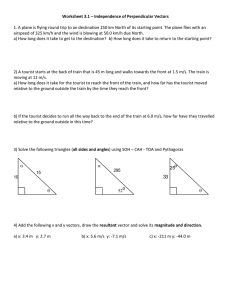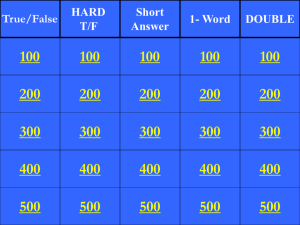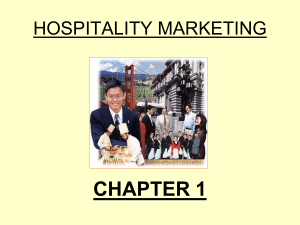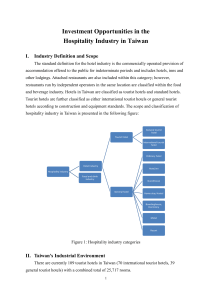Investment in the hospitality Industry Industry Definition and Scope
advertisement
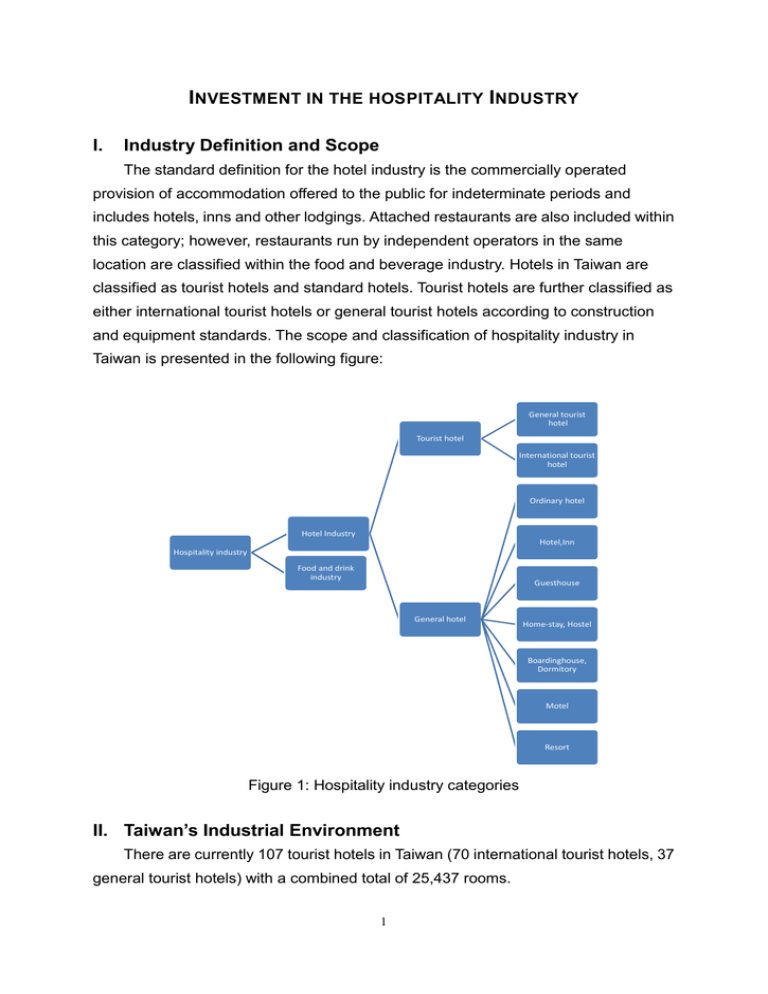
INVESTMENT IN THE HOSPITALITY INDUSTRY I. Industry Definition and Scope The standard definition for the hotel industry is the commercially operated provision of accommodation offered to the public for indeterminate periods and includes hotels, inns and other lodgings. Attached restaurants are also included within this category; however, restaurants run by independent operators in the same location are classified within the food and beverage industry. Hotels in Taiwan are classified as tourist hotels and standard hotels. Tourist hotels are further classified as either international tourist hotels or general tourist hotels according to construction and equipment standards. The scope and classification of hospitality industry in Taiwan is presented in the following figure: General tourist hotel Tourist hotel International tourist hotel Ordinary hotel Hotel Industry Hotel,Inn Hospitality industry Food and drink industry Guesthouse General hotel Home-stay, Hostel Boardinghouse, Dormitory Motel Resort Figure 1: Hospitality industry categories II. Taiwan’s Industrial Environment There are currently 107 tourist hotels in Taiwan (70 international tourist hotels, 37 general tourist hotels) with a combined total of 25,437 rooms. 1 Taiwan tourist hotels and rooms numbers as of March, 2012. International Tourist Hotels General Tourist Hotels Total Number Single Double Suites Sub-total Number Single Double Suites Sub-total Number Single Double Suites Sub-total of rooms rooms of hotels 70 rooms rooms of hotels rooms rooms hotels 7,032 11,274 2,076 20,382 37 2,197 2,264 594 5,055 107 9,229 13,538 2,670 Source: Tourist Bureau, Rep. of China (Taiwan), May, 2012. As of 2011 the number of international tourist hotels in Taiwan numbered 70. Their locations throughout Taiwan are indicated in the following table: International tourist hotel distribution in Taiwan Taipei Kaohsiung Taoyuan, Taichung Hualien Scenic Hsinchu and areas Miaoli Number 24 9 7 5 5 Other 13 Total 7 of hotels Source: International tourist hotel operations report, Tourism Bureau III. Analysis of Industry Chain Gap 1. Hospitality industry value chain The hospitality industry value chain includes upstream food and beverage vendors (perishable foods, beverages and general supplies) as well as booking services and goods providers (individual, corporate and agency Internet reservations; room supplies), midstream vendors of material for hotel dining rooms and room supplies, and the downstream consumers. 2 70 25,437 Upstream Food and beverage Midstream Downstream Perishable foods suppliers Beverage suppliers Food and beverage General goods suppliers Accommodation Internet reservations Room supplies providers Individual reservations Raw materials and ingredients suppliers International tourist hotel Consumers Reservations Agency reservations Corporate reservations 1 2. Industry gap analysis Hotel construction and the ability to beak into international tourism marketing and booking channels are two gaps in the hospitality industry that were revealed after the demands of the recent surge of Mainland Chinese and other international tourists. For example Mainland Chinese tourists, regardless of whether they join a tour group or come independently, still rely on their domestic travel agencies for reservations and other travel arrangements within Taiwan. Therefore, creating awareness of Taiwanese hotels through marketing or co-operation is critical to breaking into these channels. IV. Investment Advantages in Taiwan (1)Compared with other Asian countries Taiwan’s culture is diverse and innovative. Taiwan’s infrastructure and transportation are highly developed; management personnel, security, health and hygiene standards and other national indicators are all advantageous compared with Southeast Asian countries. (2) For targeting Chinese-speaking markets: (a) Taiwan has cultural and language advantages over competitors such as South Korea; (b) compared to Singapore and Hong Kong, Taiwan’s geographic area is much larger and offers more opportunities for further development; (c) as the number of Mainland Chinese tourists coming to Taiwan progressively increases, Mainland companies investing in Taiwan will have considerable niche investment opportunities through their understanding of Chinese tourist travel habits and characteristics. (3)Taiwan possesses excellent hotel management capabilities, talented human resources and rich international experience. 3 (4)The implementation of the Tourism Bureau’s Project Vanguard for Excellence in Tourism has created more refined and targeted selling points for the hospitality industry while driving corresponding demand for its services. V. Business Opportunities and Potential In 2011 tourist arrivals to Taiwan were 6.08 million, up from 4.4 million in 2009. The biggest source of growth came from Mainland China. In 2010 China surpassed Japan as the number one source of visitors. The number of Mainland Chinese tourists coming to Taiwan increased 9.41% in 2011, reaching 1,784,185 arrivals. Of these 1,290,933 came for “sightseeing,” an increase of 5.12%; and 125,481 came for “business.” With the further opening up of the Taiwan market to independent travellers from the Mainland, Taiwan’s tourist market still has a large potential for further growth and development. Looking to the future a number of factors will provide additional growth opportunities for the Taiwan tourist market. These include recovery of the global economy, simplification and relaxation of travel regulations between the two sides of the Taiwan Strait, continued cultivation of important source markets in East Asia, North America and Europe and exploration of emerging source markets (e.g., Southeast Asia, Middle East and the countries of BRICS). In 2012 tourist arrivals are estimated to increase another 10% to 6.6 million. VI. Policies and Incentives Measures The government has instituted a multi-faceted approach to further deepen and broaden the development platform for the hospitality industries through various measures and programs. Driven by a $1 billion USD investment in Project Vanguard for Excellence in Tourism, tourism revenue is expected to reach $18.3 billion US in 2012, supporting 400,000 jobs in tourism related industries. This is expected to attract an additional $6.67 billion US in private investments and the introduction of at least 10 internationally known hotel chains in line with program targets. An additional government program developed one flagship attraction in each of five regions throughout Taiwan as well as various other international-quality sightseeing spots. Meanwhile an industry revitalization plan has been implemented to 4 stimulate renovations, operations upgrades, encouragement of local hotels to join hotel branding associations, acquire professional certification and reward innovative product and package sales. Furthermore international hotels chains were encouraged to construct large-scale events (MICE) facilities as well as cross-industry hotel combinations in cooperation with the health and beauty, spa, ecology, aboriginal, agriculture and cultural and creative industries. Finally an upgrade action program has helped develop the market through the establishment of the Taiwan International Tourist Development Center and improve quality through hotel ranking accreditation and bed and breakfast certification. All these important programs provide direction for the future development of Taiwan’s hospitality industry. 5

